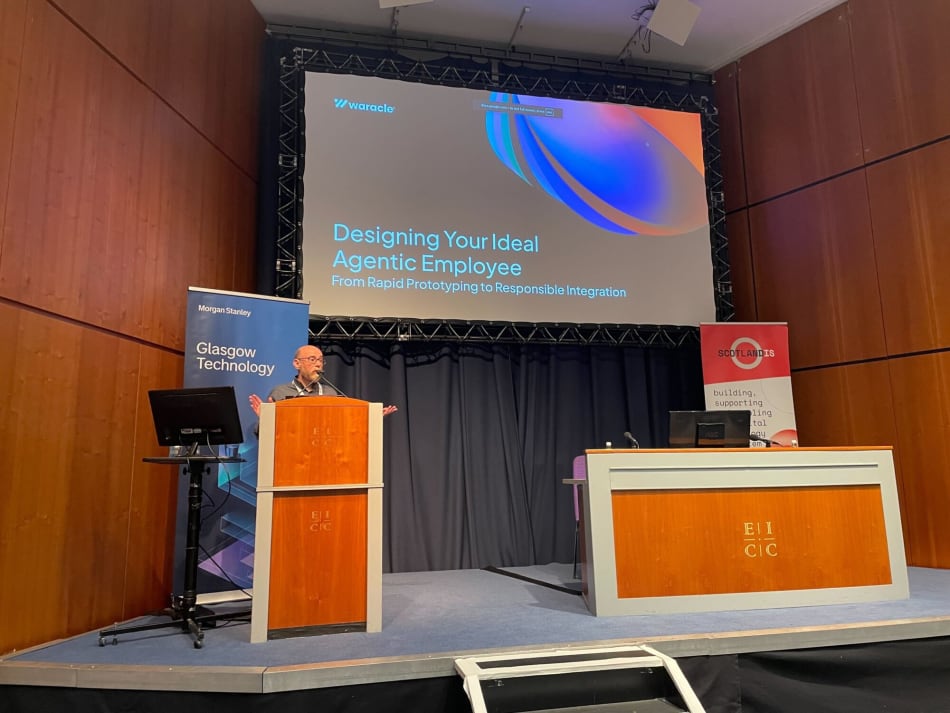
The workplace is on the verge of a major change. As enterprise technology continues to advance at speed, the rise of a new approach promises to redefine how organisations manage productivity, compliance and customer service. We’re talking about “agentic employees” – intelligent AI agents that don’t just assist with work, but actively perform it on behalf of teams across your organisation.
At Waracle, where we’ve spent over 15 years creating intelligent digital products for enterprise clients across Health, Financial Services, Energy, and the Public Sector, we’re seeing firsthand how this shift from experimental AI to operational AI agents is creating unprecedented opportunities for businesses ready to embrace responsible innovation.
The Shadow AI Economy: A Wake-Up Call for Enterprise
Before we dive into how to build effective agentic employees, let’s address the elephant in the boardroom: the shadow AI economy.
Right now, across organisations of every size, employees are quietly using personal ChatGPT, Gemini, and Claude accounts to complete work tasks. They’re drafting emails, analysing data, generating reports, and solving problems – often achieving better ROI than formal AI initiatives that remain trapped in pilot purgatory.
This isn’t a problem to be stamped out through policy restrictions. It’s a signal. Your people are telling you they need accessible, integrated AI solutions that actually work within their daily workflows. The question isn’t whether AI agents will become part of your workforce – it’s whether you’ll design them thoughtfully or let them proliferate in an uncontrolled, ungoverned manner.
Beyond Simple Prompts: The Architecture of Agentic Intelligence
The difference between using ChatGPT for a quick task and deploying an agentic employee is like the difference between asking someone for directions and hiring a professional guide who knows the terrain intimately.
Traditional LLM interactions rely on simple prompts: “Write me an email” or “Summarise this document.” Agentic prompts are different. They’re sophisticated frameworks that define not just what the agent should do, but how it should think, act, and learn.
An effective agentic prompt architecture includes six critical components:
1 – Role Definition: What is this agent’s purpose within your organisation? Is it a compliance guardian, a marketing content specialist, or a customer service representative? Clarity here determines everything that follows.
2 – Goal Articulation: What specific, measurable objectives must the agent achieve? Vague goals produce vague results.
3 – Task Breakdown: How will the agent accomplish its mission, step by step? This is where you translate organisational knowledge into executable workflows.
4 – Constraints and Guardrails: What limitations, rules, and compliance requirements must the agent respect? This is paramount in regulated industries where deviation isn’t just problematic – it’s potentially catastrophic.
5 – Tool Access: What resources, databases, APIs, and applications can the agent leverage? This is where the Model Context Protocol (MCP) becomes transformative.
6 – Reflection Mechanisms: How will the agent evaluate its own performance, identify errors, and improve over time? Without this, you have automation, not intelligence.
This structured approach ensures that agents don’t just execute tasks – they understand context, maintain consistency, and operate within the boundaries that protect your brand and your customers.

The Model Context Protocol: Breaking Down Data Silos
One of the biggest challenges in enterprise AI isn’t the intelligence of the models – it’s getting them to work with your actual data and systems.
The Model Context Protocol (MCP) is an open standard designed to solve exactly this problem. It enables LLM applications to seamlessly integrate with external data sources, internal databases, CRM systems, compliance tools, and more. Rather than each AI implementation requiring custom integrations, MCP provides a standardised approach that dramatically expands what agents can actually do in your environment.
For organisations working across highly regulated sectors like financial services or healthcare, this is essential. Your agentic employees need to access real-time data, reference current policies, and interact with existing systems whilst maintaining security, auditability, and compliance at every step.
Building Agents That Serve Every Team
The true power of agentic employees emerges when you move beyond one-off experiments and start building agents tailored to different teams and functions across your organisation.
Compliance Agents can continuously monitor communications, flag potential regulatory issues, and ensure adherence to ever-changing requirements – reducing human error whilst freeing your compliance team to focus on strategic risk management rather than manual review.
Marketing Agents can craft compelling content that stays on-brand, analyse market trends in real-time, and personalise customer communications at scale – all whilst maintaining the consistent voice and messaging that protects your brand equity.
Customer Service Agents can provide instant, personalised support that draws on your complete knowledge base, understands customer history, and escalates complex issues appropriately – delivering the kind of responsive, empathetic service that builds loyalty.
The benefits cascade across your organisation: improved efficiency through automation of repetitive tasks, enhanced compliance through consistent application of rules, maintained brand consistency across all touchpoints, and deeper customer understanding through intelligent analysis of interaction data.
But here’s the critical insight: these agents aren’t replacing your teams. They’re amplifying them. They’re taking on the repetitive, rules-based work that exhausts talented people and prevents them from applying their creativity, judgement, and strategic thinking where it matters most.
Discovery: Defining Problems Worth Solving
Here’s where many organisations stumble: they get excited about the technology and start building before they’ve properly defined what they’re trying to achieve.
At Waracle, we know from experience that exceptional products start with exceptional discovery. Before you deploy your first agentic employee, you need to invest time in:
Defining the Right Problems: Not every process should be automated. Not every task needs an agent. Focus on identifying the areas where agents can deliver genuine impact – where they’ll reduce friction, improve outcomes, or unlock capabilities that weren’t previously possible.
Understanding Opportunities: Where are the bottlenecks in your operations? Where do errors most commonly occur? Where do your people spend time on work that doesn’t leverage their unique human capabilities? These are your prime opportunities.
Designing for Real Needs: Your agents must be built around actual workflows and genuine user needs, not abstract possibilities. This requires deep collaboration between technology teams, business stakeholders, and the people who’ll work alongside these agents daily.
Discovery isn’t a box to tick before you get to the “real work.” It IS the real work. Get this right, and implementation becomes dramatically simpler. Get it wrong, and you’ll build technically impressive agents that nobody uses.

Testing: The Foundation of Trust
An agent that works 99% of the time is an agent that will undermine trust 100% of the time.
In highly regulated industries like financial services, healthcare, and energy, the stakes are simply too high to deploy agents without rigorous, comprehensive testing. But even in less regulated sectors, trust is everything. Your teams won’t delegate meaningful work to agents they don’t trust, and your customers certainly won’t engage with experiences they find unreliable.
Comprehensive testing for agentic employees must address five critical dimensions:
1 – Functional Correctness: Does the agent perform exactly as intended, every single time? This requires extensive scenario testing, edge case evaluation, and validation against expected outcomes.
2 – Quality Standards: Does the output meet your organisational standards? For content generation, this means tone, accuracy, and brand alignment. For decision-making, it means logic, consistency, and appropriateness.
3 – Robustness: Can the agent handle unexpected situations gracefully? What happens when it encounters ambiguous instructions, conflicting data, or edge cases nobody predicted? Fragile agents that break under pressure create more problems than they solve.
4 – Performance: Does the agent operate efficiently? Response time matters. Resource consumption matters. Scalability matters. An agent that takes three hours to complete a task a human could do in thirty minutes hasn’t delivered value.
5 – User Experience: Is the agent intuitive and pleasant to interact with? This is often overlooked in the rush to deploy functionality, but it’s absolutely critical. An agent that works but frustrates users will be abandoned.
Testing isn’t a final gate before deployment. It’s an ongoing discipline that continues throughout an agent’s operational life. As your agents learn and evolve, continuous testing ensures they remain trustworthy, reliable, and valuable.
The Path Forward: Responsible Innovation at Scale
We stand at an inflection point. The technology to build genuinely useful agentic employees is here, proven, and improving rapidly. The business case is compelling. The competitive pressure is mounting.
But the organisations that will truly succeed aren’t those that deploy agents fastest – they’re the ones that deploy them most thoughtfully.
At Waracle, we’re committed to guiding businesses through this transformation with the same rigour, expertise, and focus on genuine outcomes that has always defined our work. We believe in moving from rapid prototyping to responsible integration – building agents that are technically sophisticated, operationally effective, and trustworthy.
The future of work isn’t humans versus machines. It’s humans amplified by intelligent agents that extend our capabilities, free us from drudgery, and let us focus on what humans do best: creative thinking, strategic judgement, and genuine connection with other humans.
Your agentic employees are coming. The only question is whether you’ll design them deliberately or inherit them accidentally.
If you’re ready to explore how agentic employees could transform your organisation – with proper discovery, thoughtful design, and rigorous testing –get in touch with our team today. Let’s build something remarkable together.
Authors
Principal Technical Consultant
Related

Article • 09 December 2025
From sandbox to squad: AI-enhanced delivery in practice

Article • 05 December 2025
The art of applying stoicism to sales craft

Article • 26 November 2025
Why data infrastructure delivers value regardless of market direction

Article • 24 November 2025
Waracle accelerates growth with acquisition of Sofia-based Hacksoft

Article • 14 November 2025
Waracle secures long-term digital transformation deal with People’s Partnership

